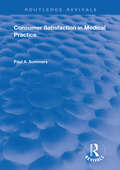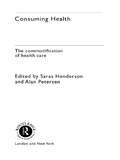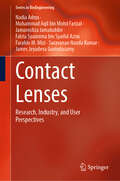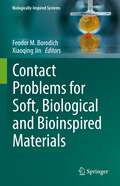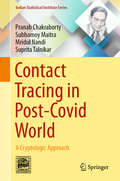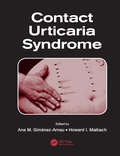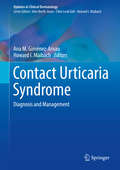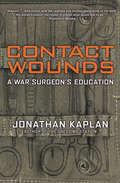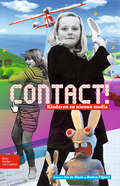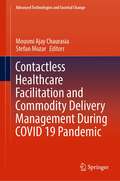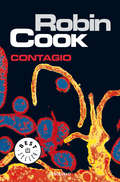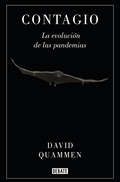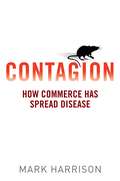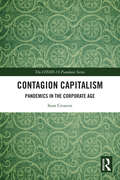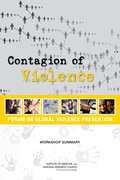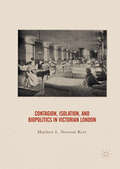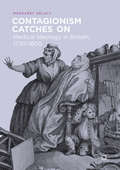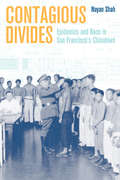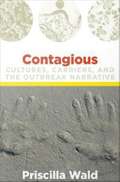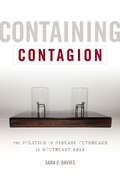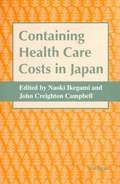- Table View
- List View
Consumer Satisfaction in Medical Practice
by William Winston Paul A SommersConsumer Satisfaction in Medical Practice will equip physicians and other decision makers in health care with the necessary tools to meet the growing demand for customers’satisfaction in medical practices. Addressing the deliverance of accurate and affective medical services, this intelligent guide provides you with proven techniques in order to provide competitive prices, convenience, accessibility, and quality outcomes to customers. Consumer Satisfaction in Medical Practice turns the delivery of health care toward the patient. Each recommendation will enable you to provide long-term and cost-effective benefits for customers and your company. Exposing common myths about medical practice, this knowledgeable book offers you a patient’s perspective on the services they need and request to help you offer your customers the appropriate services. From Consumer Satisfaction in Medical Practice, you will be able to give customers the medical services they want with the help of proven methods and suggestions which include:remembering that office budgets, profits for practitioners, and financial strengths of progressive hospitals and physician service organizations exist to help offer better health services to customerscreating a consumers’bill of rights that ensures patients that they are receiving the best possible care for their money, that every patient has a right to their own medical information, and that every patient has a right to express grievancessending out newsletters and announcements of staff changes and changes to office hours to improve physician services to patientsincorporating consumer satisfaction in employee and physician performance evaluations and setting standards for consumer satisfactionmeasuring physician staff and employee satisfaction along with that of the patient and payer to improve provider conditions and consumer satisfactionincreasing physician satisfaction by recognition through awards and an incentive systemFeaturing several charts, tables, and suggestion boxes, this guide contains effective steps that you can institute in order to offer excellent care to your customers. Consumer Satisfaction in Medical Practice allows you to expand and improve customer satisfaction for the benefit of your customers and your business.
Consumerism in the Human Services: Rationale, Evolution, Perspectives, and Policy Strategies
by David P. MoxleyThis book captures the evolution of consumerism in the human services. By addressing the changing roles and contributions of consumers (those working within human service organizations and systems and those working outside of those organizations and systems) the author offers an encompassing framework of consumerism. This framework is multidimensional and incorporates multiple types and forms of consumerism. The author offers a rationale for consumerism in the human services, illustrates its evolution, and considers multiple perspectives and models culminating in policy considerations, including specific strategies. This book will equip consumers, survivors, practitioners, and policy makers with substantive knowledge of how to advance human services through action and innovation.
Consuming Habits: Global and Historical Perspectives on How Cultures Define Drugs (2nd edition)
by Paul E. Lovejoy Jordan Goodman Andrew SherrattCovering a wide range of substances, including opium, cocaine, coffee, tobacco, kola, and betelnut, from prehistory to the present day, this new edition has been extensively updated, with an updated bibliography and two new chapters on cannabis and khat. Consuming Habits is the perfect companion for all those interested in how different cultures have defined drugs across the ages. Psychoactive substances have been central to the formation of civilizations, the definition of cultural identities, and the growth of the world economy. The labeling of these substances as 'legal' or 'illegal' has diverted attention away from understanding their important cultural and historical role. This collection explores the rich analytical category of psychoactive substances from challenging historical and anthropological perspectives.
Consuming Health: The Commodification of Health Care
by Alan Petersen Saras HendersonIn our post-welfare society, health is increasingly viewed as a commodity and individuals are defined as 'health care consumers'. At the same time, the notion that the state should care for the health of its citizens is being replaced by an expectation that citizens should play a more active role in caring for themselves. These developments are by no means uncontentious. Consuming Health explores the diverse meanings and applications of the term 'consumer' in the field of health care and the implications for policy-making, health care delivery and experiences of health care. Contributors are well-known innovative researchers and lecturers from the Australia, the UK and Canada. Between them they cover a wide range of topics - from the medicalisation of the menopause to the participation of consumer groups in the national policy process - to create an original and thought-provoking text for students and practitioners in the field of health care.
Contact Dermatitis: The Molecular Basis
by Jeanne Duus Johansen Peter J. Frosch Jean-Pierre LepoittevinThe fifth edition delivers up-to-date coverage of every conceivable aspect in modern-day management of contact dermatitis. Leading experts have thoroughly updated the previous edition, while adding new chapters on genetics, the skin barrier, respiratory symptoms to chemicals and an extensive section on prevention. Both irritant and allergic contact dermatitis are covered with special emphasis on immunological mechanisms, molecular aspects of sensitizers, atypical clinical forms, reactions to medicaments, occupational and environmental aspects. The comprehensive yet approachable text is supplemented by numerous color illustrations and tables. Core messages and case reports highlight the most important information and help in gaining better understanding of the topic and greater competence in daily practice. An extensive dictionary of allergens gives quick access to specific information.
Contact Lenses: Research, Industry, and User Perspectives (Series in BioEngineering)
by Nadia Adrus Muhammad Aqil bin Mohd Farizal Jamarosliza Jamaluddin Fatria Syaimima bin Syaiful Azim Farahin M. Mizi Saravanan Nanda Kumar James Jeyadeva GovindasamyThis book covers contact lenses from its origin and history, integrated with research, industrial, and consumer perspectives. Readers will be able to acquire knowledge on the origin of contact lenses up to the evolution of basis material used for contact lens manufacturing. In terms of research perspectives, major material properties of contact lens, together with the compilation of studies for contact lens properties that had been done so far, will be served in this book, which is beneficial to the researchers. For industrial perspectives, commercialization of contact lenses will be discussed, including the steps in manufacturing contact lenses and other aspects in the industry including the latest challenges, development, and improvement in contact lens. Moreover, this book gives exposure on the type of contact lens that is available in the market and some useful guidelines for contact lens users.
Contact Problems for Soft, Biological and Bioinspired Materials (Biologically-Inspired Systems #15)
by Feodor M. Borodich Xiaoqing JinThis book contains contributions from leading researchers in biomechanics, nanomechanics, tribology, contact mechanics, materials science and applications on various experimental techniques including atomic force microscopy (AFM) for studying soft, biomimetic and biological materials and objects. Biologists, physicists, researchers applying methods of contact mechanics and researchers testing materials using indentation techniques along with many other applied scientists will find this book a useful addition to their libraries. Moreover, several reviews in this book are written as introductions to several important and rather sophisticated research areas such as depth-sensing indentation, studying of biological cells by AFM probes, mechanics of adhesive contact and contact between viscoelastic (hereditary elastic) solids. The book containing new theoretical models, results of experimental studies and numerical simulations, along with reviews of above mentioned areas of contact mechanics in application to biological systems, would be beneficial for researchers in many areas of biology, medicine, engineering, mechanics and biomimetics.
Contact Tracing in Post-Covid World: A Cryptologic Approach (Indian Statistical Institute Series)
by Mridul Nandi Subhamoy Maitra Pranab Chakraborty Suprita TalnikarThis book is a timely document of state-of-the-art techniques in the domain of contact tracing applications. Well known in the field of medical science, this topic has recently received attention from governments, industries and academic communities due to the COVID-19 pandemic. This book provides a link between new proposals related to contact tracing applications and a contextual literature review primarily from the cryptologic viewpoint. As these applications are related to security and privacy of individuals, analyzing them from cryptologic viewpoint is of utmost importance. Therefore, present developments from cryptologic aspects of most proposals around the world, including Singapore, Europe, USA, Australia and India, have been discussed. Providing an in-depth study on the design rationale of each protocol, this book is of value to researchers, students and professionals alike.
Contact Urticaria Syndrome: Diagnosis And Management (Updates in Clinical Dermatology)
by Howard I. Maibach Ana M. Gimenez-ArnauContact urticaria syndrome was first defined in 1975 and since then scientific interest has steadily increased. New cases are continuously being reported furnishing information on novel clinical features. A large number of compounds could be responsible for triggering the syndrome including fragrances, cosmetics, latex, preservatives, flavorings, a
Contact Urticaria Syndrome: Diagnosis and Management (Updates in Clinical Dermatology)
by Howard I. Maibach Ana M. Giménez-ArnauContact urticaria is an immediate but transient localized swelling and redness that occurs on the skin after direct contact with an offending substance. It is caused by a variety of compounds, such as foods, preservatives, fragrances, plant and animal products, metals, and rubber latex and the mechanism by which these provoke an immediate urticarial rash at the area of contact can be divided into two categories: non-immunological contact urticaria and immunological (allergic) contact urticaria. Non-immunological contact urticaria typically causes mild localized reactions that clear within hours, e.g. stinging nettle rash. This type of urticaria occurs without prior exposure of a patient's immune system to an allergen. Immunological contact urticaria occurs most commonly in atopic individuals (people who are prone to allergy). Hence prior exposure to an allergen is required for this type of contact urticaria to occur. While there have been other texts written on the subject over the last decade, this book is intended as an easily accessible guide for dermatologists and residents, as well as general practitioners, summarizing the most important concepts that will help physicians identify the signs and symptoms of Contact Urticaria Syndrome in their daily clinical practice. Each chapter is laid out in the following format: Concepts, Tools and Algorithms of Diagnosis and Management, a Clinical Case for each entry, and Recommendations. Additionally, the Volume Editors have worked to provide a global approach to this syndrome using internationally standardized requirements for diagnosis.
Contact Wounds: A War Surgeon's Education
by Jonathan KaplanSurgery is the crude art of cutting people open, yet it is also a symphony of delicate manipulation and subtle chords. So says Jonathan Kaplan in his stunning book Contact Wounds, an electrifying account of a doctor’s education in the classroom, in life, and on the battlefield. Inspired by his father, a military surgeon in World War II and Israel’s nascent fight for statehood, Kaplan became a doctor and was appointed to a post at a woefully understaffed South African general hospital in a black township. Fleeing apartheid, he traveled the globe in search of sanctuary, experiencing riots, tropical fevers, political upheaval, and a jungle search for a lost friend. Kaplan eventually landed in Angola, taking charge of a combat-zone hospital, the only surgeon for 160,000 civilians, where he was exposed daily to the horrors of war. Journeying further into dangerous territory, Kaplan portrays serving as a volunteer surgeon in Baghdad-where he treated civilian casualties amid gunfights for control of hospitals and dealt with gangs of AK-47-wielding looters stripping pharmacies. Contact Wounds is a stirring testament of adventure, discovery, survival, and the making of a career devoted to saving people caught in the crossfire of war.
Contact!: Kinderen en nieuwe media
by R. Pijpers J. De HaanDit boek gaat over het gebruik van nieuwe media - internet, games en mobiele telefonie - bij kinderen in de basisschoolleeftijd. Bij kinderen draaien nieuwe media in eerste instantie om contact. Ze spelen samen met vrienden games, op spelcomputers, op spelletjeswebsites en in virtuele werelden als Stardoll.nl en Habbo. Ze bekijken filmpjes op YouTube en soms maken ze die zelf om ze vervolgens met anderen te delen. Ze hebben contact met elkaar via de mobiele telefoon en MSN. Ze 'krabbelen' elkaar op Hyves en presenteren zichzelf daar aan elkaar. Vriendschap, liefde, ruzie en pesten; alles uit het echte leven heeft ook een plaats in hun digitale leefwereld. Op steeds jongere leeftijd zijn kinderen actief met nieuwe media. Sommige ouders en leerkrachten worstelen met het mediagebruik van (jonge) kinderen. Ze vragen zich af hoe de nieuwe mogelijkheden het best benut kunnen worden en hoe gevaren vermeden kunnen worden. Wat moeten kinderen leren om veilig en efficiënt met nieuwe media om te gaan? Welke vaardigheden zijn er nodig om mediawijze burgers van hen te maken? En wat zijn hierbij taken van opvoeders? Het boek Contact! Kinderen en nieuwe media brengt het werk van de beste onderzoekers in Nederland op dit terrein samen. De auteurs genieten internationaal een uitstekende reputatie en het boek mag nu al een standaardwerk genoemd worden. Het is bij uitstek geschikt om ouders, onderwijzers en hulpverleners wegwijs te maken in de digitale leefwereld van kinderen. Het boek is een initiatief van het Sociaal Cultureel Planbureau (SCP), Stichting Mijn Kind Online en het programma Digivaardig & Digibewust.
Contactless Healthcare Facilitation and Commodity Delivery Management During COVID 19 Pandemic (Advanced Technologies and Societal Change)
by Stefan Mozar Mousmi Ajay ChaurasiaThis book offers concepts related to communication engineering principles to fight the current Covid situation, by developing contactless need-based solutions. COVID-19, a global pandemic makes us rethink how governments, organizations, and societies around the world can work with minimum or without physical contact. Technologies like artificial intelligence and big data are playing an essential role in responding to the COVID-19 pandemic. This book is a combination of chapters related to imaging and detective technologies used by the experts to fight the COVID-19 pandemic and a combination of interesting content covering the need of hour solutions generated through cutting edge technologies. In the absence of a proper medicine or vaccine, it is quite evident that nutrition plays an important role in the quick recovery of covid patients which must be very carefully planned with proper diagnostics. Data analysis and X-Ray/CT Image analysis by next-generation techniques like deep sensing, machine learning is interesting and useful for research and applied healthcare professionals. Research findings with a focus on diagnostics and reports generated through important data analysis in the book are quite useful and can be referred to by researchers and professionals working in the area of cutting-edge technologies against COVID 19.
Contagio
by Robin CookLa repentina aparición de una catastrófica epidemia en Nueva York lleva al Dr. Stapleton a destapar los oscuros planes de una importante empresa médica estadounidense. Al oftalmólogo Jack Stapleton todo empieza a irle mal: se ve obligado a cerrar su consulta médica a causa de la competencia desleal de AmeriCare, una gran empresa médica privada, y seguidamente pierde a su mujer y a sus hijas en un accidente de avión. Destrozado y perplejo, Jack intenta rehacer su vida trasladándose a Nueva York y dedicándose a la medicina forense. Pero Jack no imaginaba que su nuevo trabajo iba a conducirle a las puertas del infierno. En las clínicas y los hospitales controlados por AmeriCare comienza a producirse una serie de repentinos brotes de virus raros y diferentes que provocan la muerte de varios pacientes. A pesar de no contar con la aprobación de sus superiores, Jack comienza a investigar movido por la inquietante sospecha de una oscura conspiración de proporciones inesperadas. La crítica ha dicho...«Un maestro en el arte de inquietar.»ABC «Un thriller sobrecogedor e impactante.»El Periódico
Contagio: La evolución de las pandemias
by David QuammenEL LIBRO INTERNACIONAL DE REFERENCIA DURANTE LA CUARENTENA. Desde hace años, para los expertos y cualquier persona informada, el estallido de la siguiente pandemia era una cuestión de tiempo, y su origen, evidente: un virus latente en animales que diera el salto al ser humano como el HIV que provocó el SIDA o el H1N1 que causó la gripe de 1918, el ébola, el SARS, el virus de Marburgo o el que produjo la gripe aviar. En esta obra de referencia internacional, David Quammen se sumerge en la historia reciente de esas enfermedades zoonóticas, y persigue su rastro en compañía de los mejores científicos del mundo en la selva centroafricana, las cuevas de China meridional o las azoteas de Bangladés, pero también en los sofisticados laboratorios cuyo personal investiga virus letales bajo las más altas medidas de seguridad. Aunque Contagio se lee como un thriller, repleto de incidentes, pistas e interrogantes, a la vista de la crisis desatada por la aparición del SARS-CoV-2, su lectura no solo resulta apasionante; es imprescindible. Reseñas:«Quammen es el mejor reportero del mundo natural.»Parul Sehgal, The New York Times «David Quammen es el mejor escritor de historia natural; sus libros impresionan por su precisión, su energía y su escritura brillante y evocativa.»David Barash, The Wall Streer Journal «El libro que me ayudó a entender la dinámica de lo que estaba pasando.»Paolo Giordano «Deslumbrante Quammen: desvela lo que nos hace vivir y lo que nos mata con pasión, humor y conocimiento.»Daniel Arjona, El confidencial «Un libro aterrador pero fundamental para entender la próxima pandemia global.»Publishers' Weekly «Que Quammen no haya ganado un premio Pulitzer es una auténtica vergüenza.»Dwight Garner, The New York Times «Una obra esencial.»Booklist (Starred Review)
Contagion
by Mark HarrisonMuch as we take comfort in the belief that modern medicine and public health tactics can protect us from horrifying contagious diseases, such faith is dangerously unfounded. So demonstrates Mark Harrison in this pathbreaking investigation of the intimate connections between trade and disease throughout modern history. For centuries commerce has been the single most important factor in spreading diseases to different parts of the world, the author shows, and today the same is true. But in today's global world, commodities and germs are circulating with unprecedented speed. Beginning with the plagues that ravaged Eurasia in the fourteenth century, Harrison charts both the passage of disease and the desperate measures to prevent it. He examines the emergence of public health in the Western world, its subsequent development elsewhere, and a recurring pattern of misappropriation of quarantines, embargoes, and other sanitary measures for political or economic gain—even for use as weapons of war. In concluding chapters the author exposes the weaknesses of today's public health regulations—a set of rules that not only disrupt the global economy but also fail to protect the public from the afflictions of trade-borne disease.
Contagion Capitalism: Pandemics in the Corporate Age (The COVID-19 Pandemic Series)
by Sean CreavenContagion Capitalism situates the COVID-19 pandemic within the systems of global political economy and their attendant cultural modes and theorizes that these systems act as facilitators and drivers of global pandemic risk. Contagion Capitalism therefore critiques the institutionalized corporate-capitalist control of the economy, the state, and science, and the grave consequences this has on global public health policy, the ecological crisis of sustainability, and zoonotic pandemic events such as COVID-19. In doing so, this book addresses the failings of what may be termed as "state science" or "establishment science" in managing the pandemic, as personified especially by those elements of the scientific elite placed in the service of the neoliberal state. This book also explores the limitations of corporate pharmacological technoscience in safeguarding public health, arguing that ‘Big Pharma’ offers only partial remedies for problems of human illness and wellbeing, poses its own dangers to public health, and obfuscates the social bases of public ill-health and of pandemic risk. Contagion Capitalism further argues that COVID-19 will not be the last or even the most dangerous such epidemiological event. This is because the social production and global dissemination of zoonotic diseases is integral to contemporary capitalism, by virtue of its instrumental mode of science, its central dynamic of production for the sake of accumulation, and the consumer mode this sustains as its own condition of existence. These are the drivers of what may be termed as zoonotic accelerationism. Contagion Capitalism will appeal to scholars in the humanities and social sciences with interests in neoliberal ideology and global political economy, and their impact upon social, political and cultural life.
Contagion and Chaos: Disease, Ecology, and National Security in the Era of Globalization
by Andrew T. Price-SmithAn analysis of infectious disease as a threat to national security that examines the destabilizing effects of the 1918 Spanish Flu pandemic, HIV/AIDS in sub-Saharan Africa, SARS, and Mad Cow Disease.Historians from Thucydides to William McNeill have pointed to the connections between disease and civil society. Political scientists have investigated the relationship of public health to governance, introducing the concept of health security. In Contagion and Chaos, Andrew Price-Smith offers the most comprehensive examination yet of disease through the lens of national security. Extending the analysis presented in his earlier book The Health of Nations, Price-Smith argues that epidemic disease represents a direct threat to the power of a state, eroding prosperity and destabilizing both its internal politics and its relationships with other states. He contends that the danger of an infectious pathogen to national security depends on lethality, transmissability, fear, and economic damage. Moreover, warfare and ecological change contribute to the spread of disease and act as “disease amplifiers.” Price-Smith presents a series of case studies to illustrate his argument: the Spanish influenza pandemic of 1918-19 (about which he advances the controversial claim that the epidemic contributed to the defeat of Germany and Austria); HIV/AIDS in sub-Saharan Africa (he contrasts the worst-case scenario of Zimbabwe with the more stable Botswana); bovine spongiform encephalopathy (also known as mad cow disease); and the SARS contagion of 2002-03. Emerging infectious disease continues to present a threat to national and international security, Price-Smith argues, and globalization and ecological change only accelerate the danger.
Contagion of Violence
by Deepali M. PatelThe past 25 years have seen a major paradigm shift in the field of violence prevention, from the assumption that violence is inevitable to the recognition that violence is preventable. Part of this shift has occurred in thinking about why violence occurs, and where intervention points might lie. In exploring the occurrence of violence, researchers have recognized the tendency for violent acts to cluster, to spread from place to place, and to mutate from one type to another. Furthermore, violent acts are often preceded or followed by other violent acts. In the field of public health, such a process has also been seen in the infectious disease model, in which an agent or vector initiates a specific biological pathway leading to symptoms of disease and infectivity. The agent transmits from individual to individual, and levels of the disease in the population above the baseline constitute an epidemic. Although violence does not have a readily observable biological agent as an initiator, it can follow similar epidemiological pathways. On April 30-May 1, 2012, the Institute of Medicine (IOM) Forum on Global Violence Prevention convened a workshop to explore the contagious nature of violence. Part of the Forum's mandate is to engage in multisectoral, multidirectional dialogue that explores crosscutting, evidence-based approaches to violence prevention, and the Forum has convened four workshops to this point exploring various elements of violence prevention. The workshops are designed to examine such approaches from multiple perspectives and at multiple levels of society. In particular, the workshop on the contagion of violence focused on exploring the epidemiology of the contagion, describing possible processes and mechanisms by which violence is transmitted, examining how contextual factors mitigate or exacerbate the issue. Contagion of Violence: Workshop Summary covers the major topics that arose during the 2-day workshop. It is organized by important elements of the infectious disease model so as to present the contagion of violence in a larger context and in a more compelling and comprehensive way.
Contagion, Isolation, and Biopolitics in Victorian London
by Matthew L. Newsom KerrThis book is a history of London's vast network of fever and smallpox hospitals, built by the Metropolitan Asylums Board between 1870 and 1900. Unprecedented in size and scope, this public infrastructure inaugurated a new technology of disease prevention--isolation. Londoners suffering from infectious diseases submitted themselves to far-reaching forms of surveillance, removal, and detention, which made them legible to science and the state in entirely new ways. Isolation on a mass scale transformed the meaning of urban epidemics and introduced contentious new relationships between health, citizenship, and the spaces of modern governance. Rich in archival sources and images, this engaging book offers innovative analysis at the intersection of preventive medicine and Victorian-era liberalism.
Contagionism Catches On: Medical Ideology in Britain, 1730-1800
by Margaret DelacyThis book shows how contagionism evolved in eighteenth century Britain and describes the consequences of this evolution. By the late eighteenth century, the British medical profession was divided between traditionalists, who attributed acute diseases to the interaction of internal imbalances with external factors such as weather, and reformers, who blamed contagious pathogens. The reformers, who were often "outsiders," English Nonconformists or men born outside England, emerged from three coincidental transformations: transformation in medical ideas, in the nature and content of medical education, and in the sort of men who became physicians. Adopting contagionism led them to see acute diseases as separate entities, spurring a process that reoriented medical research, changed communities, established new medical institutions, and continues to the present day.
Contagious Divides: Epidemics and Race in San Francisco’s Chinatown (American Crossroads #7)
by Nayan ShahContagious Divides charts the dynamic transformation of representations of Chinese immigrants from medical menace in the nineteenth century to model citizen in the mid-twentieth century. Examining the cultural politics of public health and Chinese immigration in San Francisco, this book looks at the history of racial formation in the U.S. by focusing on the development of public health bureaucracies. <P><P>Nayan Shah notes how the production of Chinese difference and white, heterosexual norms in public health policy affected social lives, politics, and cultural expression. Public health authorities depicted Chinese immigrants as filthy and diseased, as the carriers of such incurable afflictions as smallpox, syphilis, and bubonic plague. This resulted in the vociferous enforcement of sanitary regulations on the Chinese community. But the authorities did more than demonize the Chinese; they also marshaled civic resources that promoted sewer construction, vaccination programs, and public health management. Shah shows how Chinese Americans responded to health regulations and allegations with persuasive political speeches, lawsuits, boycotts, violent protests, and poems. <P><P> Chinese American activists drew upon public health strategies in their advocacy for health services and public housing. Adroitly employing discourses of race and health, these activists argued that Chinese Americans were worthy and deserving of sharing in the resources of American society.
Contagious: Cultures, Carriers, and the Outbreak Narrative
by Priscilla WaldHow should we understand the fear and fascination elicited by the accounts of communicable disease outbreaks that proliferated, following the emergence of HIV, in scientific publications and the mainstream media? The repetition of particular characters, images, and story lines--of Patients Zero and superspreaders, hot zones and tenacious microbes--produced a formulaic narrative as they circulated through the media and were amplified in popular fiction and film. The "outbreak narrative" begins with the identification of an emerging infection, follows it through the global networks of contact and contagion, and ends with the epidemiological work that contains it. Priscilla Wald argues that we need to understand the appeal and persistence of the outbreak narrative because the stories we tell about disease emergence have consequences. As they disseminate information, they affect survival rates and contagion routes. They upset economies. They promote or mitigate the stigmatizing of individuals, groups, locales, behaviors, and lifestyles. Wald traces how changing ideas about disease emergence and social interaction coalesced in the outbreak narrative. She returns to the early years of microbiology--to the identification of microbes and "Typhoid Mary," the first known healthy human carrier of typhoid in the United States--to highlight the intertwined production of sociological theories of group formation ("social contagion") and medical theories of bacteriological infection at the turn of the twentieth century. Following the evolution of these ideas, Wald shows how they were affected by--or reflected in--the advent of virology, Cold War ideas about "alien" infiltration, science-fiction stories of brainwashing and body snatchers, and the HIV/AIDS pandemic. Contagious is a cautionary tale about how the stories we tell circumscribe our thinking about global health and human interactions as the world imagines--or refuses to imagine--the next Great Plague.
Containing Contagion: The Politics of Disease Outbreaks in Southeast Asia
by Sara E. DaviesDo states have a duty to prevent infectious disease outbreaks from spreading beyond their borders?The fields of global health and international relations are increasingly concerned with the responsibilities of nations to respond to disease outbreaks in a way that safeguards their neighbors as well as the broader international community. In Containing Contagion, Sara E. Davies focuses on one of the world's most pivotal (and riskiest) regions in the field of global health—Southeast Asia, which in recent years has responded to a wave of emerging and endemic infectious disease outbreaks ranging from Nipah, SARS, and avian flu to dengue and Japanese encephalitis.Between 2005 and 2010, Davies explains, Southeast Asian states, despite having vastly different health system capacities and political systems, repeatedly committed to pursue a collective approach to the communication of outbreaks. Davies draws on newly gathered data and extensive field interviews to explore how these states implemented the revised International Health Regulations (IHR) through the deliberate alignment of political interests and regional cooperation. Examining why these Southeast Asian states adopted a collective approach, Davies also describes the complications that ensued and traces the consequences of this approach.The first book to explore what problems exist in the relationship between international relations and health, Containing Contagion frames contrasting views of global health agency within the current crises that are facing global health. Providing an immediate, contemporary example of a region networking its response to disease outbreak events, this insightful book will appeal to global health governance scholars, students, and practitioners.
Containing Health Care Costs in Japan
by Naoki Ikegami John Creighton CampbellA comprehensive picture of costs in Japan's effective and efficient health care system.
